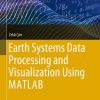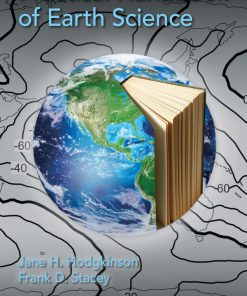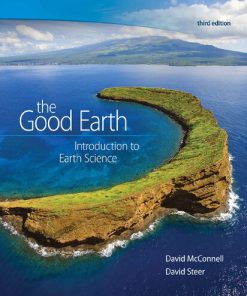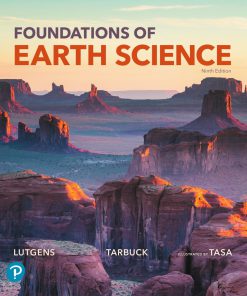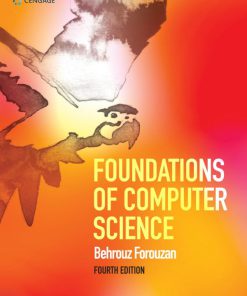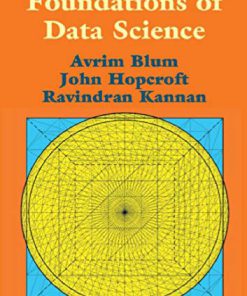Foundations of earth science 8th Edition by Frederick K Lutgens, Edward J Tarbuck, Dennis G Tasa ISBN 0134184815 9780134184814
$50.00 Original price was: $50.00.$25.00Current price is: $25.00.
Foundations of earth science 8th Edition by Frederick K Lutgens, Edward J. Tarbuck, Dennis G. Tasa – Ebook PDF Instant Download/Delivery: 0134184815, 9780134184814
Full download Foundations of earth science 8th Edition after payment
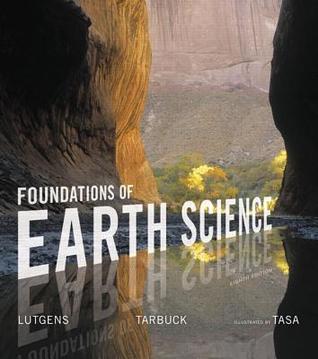
Product details:
ISBN 10: 0134184815
ISBN 13: 9780134184814
Author: Frederick K Lutgens, Edward J. Tarbuck, Dennis G. Tasa
For all introductory Earth Science courses.
Digital Content and Experiences Bring Earth Science To Life
Ideal for undergraduates with little or no science background, Foundations of Earth Science provides a student-friendly, highly visual, non-technical survey of our physical environment with balanced, up-to-date coverage of geology, oceanography, astronomy, and meteorology. Foundations of Earth Science is the brief, paperback version of the best-selling Earth Science by Lutgens and Tarbuck, and designed for introductory courses in Earth science. The new 8th Edition facilitates active learning by incorporating learning objectives throughout each chapter to provide students with a structured learning path. The learning path is tied to chapter objectives, giving students opportunities to demonstrate their understanding at the end of each section.
The 8th Edition uses the BouncePages image recognition app (available at no charge on both iOS and Android stores) to connect students’ digital devices to the print textbook, enhancing their reading and learning experience. Lutgens/Tarbuck’s innovative SmartFigures feature has been expanded, adding new digital content via Project Condor, Mobile Field Trips by Michael Collier, Animated Figures, and additional tutorial videos from Callan Bentley. This edition also includes Mastering Geology, the most complete, easy-to-use, engaging tutorial and assessment tool available.
Also Available with Mastering Geology
Mastering™ Geology is an online homework, tutorial, and assessment program designed to work with this text to engage students and improve results. Interactive, self-paced tutorials provide individualized coaching to help students stay on track. With a wide range of activities available, students can actively learn, understand, and retain even the most difficult concepts.
Note: You are purchasing a standalone product; Mastering Geology does not come packaged with this content. Students, if interested in purchasing this title with Mastering Geology, ask your instructor for the correct package ISBN and Course ID. Instructors, contact your Pearson representative for more information.
Table of contents:
Title Page
Copyright Page
Brief Table of Contents
Contents
Preface
Walkthrough
Introduction to Earth Science
I.1. What Is Earth Science
Geology
Oceanography
Meteorology
Astronomy
Scales of Space and Time in Earth Science
I.2. Earth’s Spheres
Hydrosphere
Atmosphere
Biosphere
Geosphere
I.3. Earth as a System
Earth System Science
The Earth System
I.4. Resources and Environmental Issues
Resources
Environmental Problems
I.5. The Nature of Scientific Inquiry
Hypothesis
Theory
Scientific Methods
Unit I: Earth Materials
1. Matter and Minerals
1.1. Minerals: Building Blocks of Rocks
1.2. Atoms: Building Blocks of Minerals
1.3. Why Atoms Bond
1.4. Properties of Minerals
1.5. Mineral Groups
2. Rocks: Materials of the Solid Earth
2.1. Earth as a System: The Rock Cycle
2.2. Igneous Rocks: “Formed by Fire”
2.3. Weathering of Rocks to Form Sediment
2.4. Sedimentary Rocks: Compacted and Cemented Sediment
2.5. Metamorphic Rocks: New Rock from Old
Unit II: Sculpting Earth’s Surface
3. Landscapes Fashioned by Water
3.1. Earth’s External Processes
3.2. Mass Wasting: The Work of Gravity
3.3. The Hydrologic Cycle
3.4. Running Water
3.5. Streamflow Characteristics
3.6. The Work of Running Water
3.7. Stream Channels
3.8. Shaping Stream Valleys
3.9. Depositional Landforms
3.10. Floods and Flood Control
3.11. Groundwater: Water Beneath the Surface
3.12. Springs, Wells, and Artesian Systems
3.13. Environmental Problems of Groundwater
3.14. The Geologic Work of Groundwater
4. Glacial and Arid Landscapes
4.1. Glaciers and the Earth System
4.2. How Glaciers Move
4.3. Glacial Erosion
4.4. Glacial Deposits
4.5. Other Effects of Ice Age Glaciers
4.6. Extent of Ice Age Glaciation
4.7. Deserts
4.8. Basin and Range: The Evolution of a Mountainous Desert Landscape
4.9. The Work of Wind
Unit III: Forces Within
5. Plate Tectonics: A Scientific Revolution Unfolds
5.1. From Continental Drift to Plate Tectonics
5.2. Continental Drift: An Idea Before Its Time
5.3. The Theory of Plate Tectonics
5.4. Divergent Plate Boundaries and Seafloor Spreading
5.5. Convergent Plate Boundaries and Subduction
5.6. Transform Plate Boundaries
5.7. How Do Plates and Plate Boundaries Change?
5.8. Testing the Plate Tectonics Model
5.9. What Drives Plate Motions?
6. Restless Earth: Earthquakes and Mountain Building
6.1. What Is an Earthquake?
6.2. Seismology: The Study of Earthquake Waves
6.3. Where Do Most Earthquakes Occur?
6.4. Determining the Size of an Earthquake
6.5. Earthquake Destruction
6.6. Earth’s Interior
6.7. Rock Deformation
6.8. Folds: Structures Formed by Ductile Deformation
6.9. Faults and Joints: Structures Formed by Brittle Deformation
6.10. Mountain Building
6.11. Subduction and Mountain Building
6.12. Collisional Mountain Belts
7. Volcanoes and Other Igneous Activity
7.1. Mount St. Helens Versus Kilauea
7.2. The Nature of Volcanic Eruptions
7.3. Materials Extruded During an Eruption
7.4. Anatomy of a Volcano
7.5. Shield Volcanoes
7.6. Cinder Cones
7.7. Composite Volcanoes
7.8. Volcanic Hazards
7.9. Other Volcanic Landforms
7.10. Intrusive Igneous Activity
7.11. Origin of Magma
7.12. Plate Tectonics and Volcanism
Unit IV: Deciphering Earth’s History
8. Geologic Time
8.1. A Brief History of Geology
8.2. Creating a Time Scale—Relative Dating Principles
8.3. Fossils: Evidence of Past Life
8.4. Correlation of Rock Layers
8.5. Determining Numerical Dates with Radioactivity
8.6. The Geologic Time Scale
8.7. Determining Numerical Dates for Sedimentary Strata
Unit V: The Global Ocean
9. Oceans: The Last Frontier
9.1. The Vast World Ocean
9.2. Composition of Seawater
9.3. Variations in Temperature and Density with Depth
9.4. An Emerging Picture of the Ocean Floor
9.5. Continental Margins
9.6. Features of Deep-Ocean Basins
9.7. The Oceanic Ridge System
9.8. Seafloor Sediments
10. The Restless Ocean
10.1. The Ocean’s Surface Circulation
10.2. Upwelling and Deep-Ocean Circulation
10.3. The Shoreline
10.4. Beaches and Shoreline Processes
10.5. Shoreline Features
10.6. Contrasting America’s Coasts
10.7. Stabilizing the Shore
10.8. Tides
Unit VI: Earth’s Dynamic Atmosphere
11. Heating the Atmosphere
11.1. Focus on the Atmosphere
11.2. Composition of the Atmosphere
11.3. Vertical Structure of the Atmosphere
11.4. Earth–Sun Relationships
11.5. Energy, Heat, and Temperature
11.6. Heating the Atmosphere
11.7. Human Impact on Global Climate
11.8. For the Record: Air Temperature Data
11.9. Why Temperatures Vary: The Controls of Temperature
11.10. World Distribution of Temperature
12. Moisture, Clouds, and Precipitation
12.1. Water’s Changes of State
12.2. Humidity: Water Vapor in the Air
12.3. Adiabatic Temperature Changes and Cloud Formation
12.4. Processes That Lift Air
12.5. The Critical Weathermaker: Atmospheric Stability
12.6. Condensation and Cloud Formation
12.7. Types of Fog
12.8. How Precipitation Forms
12.9. Forms of Precipitation
12.10. Measuring Precipitation
13. The Atmosphere in Motion
13.1. Understanding Air Pressure
13.2. Factors Affecting Wind
13.3. Highs and Lows
13.4. General Circulation of the Atmosphere
13.5. Local Winds
13.6. Measuring Wind
13.7. Global Distribution of Precipitation
14. Weather Patterns and Severe Weather
14.1. Air Masses
14.2. Fronts
14.3. Midlatitude Cyclones
14.4. Thunderstorms
14.5. Tornadoes
14.6. Hurricanes
Unit VII: Earth’s Place in the Universe
15. The Nature of the Solar System
15.1. Ancient Astronomy
15.2. The Birth of Modern Astronomy
15.3. Our Solar System: An Overview
15.4. Earth’s Moon: A Chip Off the Old Block
15.5. Terrestrial Planets
15.6. Jovian Planets
15.7. Small Solar System Bodies
16. Beyond Our Solar System
16.1. The Universe
16.2. Classifying Stars: Hertzsprung–Russell Diagrams (H-R Diagrams)
16.3. Stellar Evolution
16.4. Stellar Remnants
16.5. Galaxies and Galactic Clusters
16.6. The Big Bang Theory
Appendix A: Metric and English Units Compared
Appendix B: Relative Humidity and Dew-Point Tables
Appendix C: Stellar Properties
Glossary
Index
People also search for:
foundations of earth
foundations of earth science by tarbuck
foundations of earth science by tarbuck pdf
foundations of the earth in job
what are the foundations of the earth
Tags: Frederick K Lutgens, Edward J Tarbuck, Dennis G Tasa, Foundations, earth science
You may also like…
Earth Sciences - Reference
Practical Handbook of Earth Science 1st Edition Jane H. Hodgkinson
Mathematics - Computational Mathematics
Mathematical Foundations of Computer Science 1st Edition Satyanarayana 1000702715 9781032654195
Earth Sciences - Geography
The good Earth introduction to earth science 3rd Edition by David Mcconnell 0073524107 9780073524108
Earth Sciences
Historical Geology Evolution of the Earth and Life Through Time Eighth Edition Reed Wicander
Earth Sciences - Geology
Computers - Organization and Data Processing



